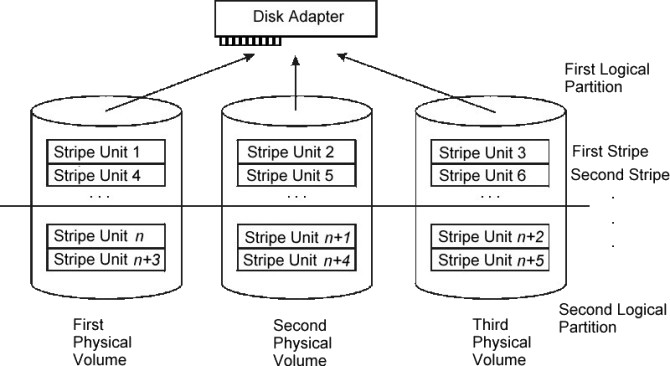
Striping is a technique for spreading the data in a logical volume across several disk drives in such a way that the I/O capacity of the disk drives can be used in parallel to access data on the logical volume. The primary objective of striping is very high-performance reading and writing of large sequential files, but there are also benefits for random access. The following illustration gives a simple example.
Figure 8-4. Striped Logical Volume /dev/lvs0. This illustration shows three physical volumes or drives. Each physical drive is partitioned into two logical volumes. The first partition, or logical volume, of drive 1 contains stripe unit 1 and 4. Partition 1 of drive 2 contains stripe unit 2 and 5 and partition 1 of drive 3 contains stripe unit 3 and 6. The second partition of drive one contains stripe unit n and n+3. The second partition of drive 2 contains stripe unit n+1 and n+4. Partition 2 of drive 3 contains stripe unit n+2 and n+5.
 |
In an ordinary logical volume, the data addresses correspond to the sequence of blocks in the underlying physical partitions. In a striped logical volume, the data addresses follow the sequence of stripe units. A complete stripe consists of one stripe unit on each of the physical devices that contains part of the striped logical volume. The LVM determines which physical blocks on which physical drives correspond to a block being read or written. If more than one drive is involved, the necessary I/O operations are scheduled for all drives simultaneously.
As an example, a hypothetical lvs0 has a stripe-unit size of 64 KB, consists of six 2 MB partitions, and contains a journaled file system (JFS). If an application is reading a large sequential file and read-ahead has reached a steady state, each read will result in two or three I/Os being scheduled to each of the disk drives to read a total of eight pages (assuming that the file is on consecutive blocks in the logical volume). The read operations are performed in the order determined by the disk device driver. The requested data is assembled from the various pieces of input and returned to the application.
Although each disk device will have a different initial latency, depending on where its accessor was at the beginning of the operation, after the process reaches a steady state, all three disks should be reading at close to their maximum speed.
When a striped logical volume is defined, you specify:
Sequential and random disk I/Os benefit from disk striping. The following techniques have yielded the highest levels of sequential I/O throughput:
char *buffer; buffer = malloc(MAXBLKSIZE+64); buffer = ((int)buffer + 64) & ~0x3f;
If the striped logical volumes are on raw logical volumes and writes larger than 1.125 MB are being done to these striped raw logical volumes, increasing the lvm_bufcnt parameter with the command vmtune -u might increase throughput of the write activity. See Miscellaneous I/O Tuning Parameters.
Also, it is not a good idea to mix striped and non-striped logical volumes in the same physical volume. All physical volumes should be the same size within a set of striped logical volumes.
AIX 4.3.3 allows striping and mirroring together on the same logical volume. This feature provides a convenient mechanism for high-performance redundant storage. Measurements indicate that read and file system write performance of striping and mirroring is approximately equal to the unmirrored case, assuming you have twice as many disks.
File system writes benefit from caching in the file system, which allows considerable overlap of writes to disk with the program initiating the writes. The raw write performance suffers. Because it is synchronous, both writes must complete before control is returned to the initiating program. Performing larger writes increases raw write throughput. Also, Mirror Write Consistency (MWC) affects the performance of this case.
In summary, striping and mirroring allow redundant storage for very high-performance access.